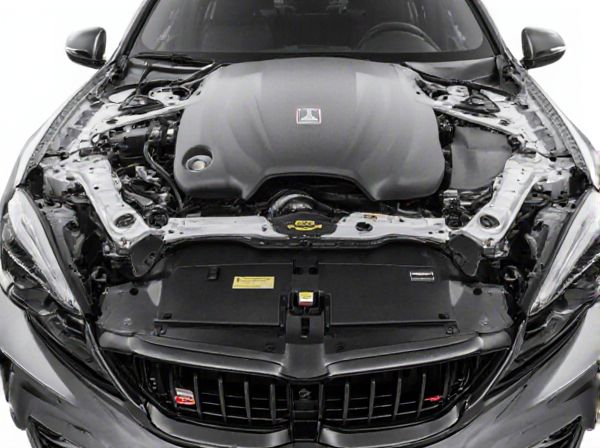
Photo illustration: Hemi Head vs Pentroof Head
Hemi heads feature a hemispherical combustion chamber that promotes efficient airflow and better combustion, leading to improved power and fuel efficiency. Pentroof heads have a slanted, multi-valve design allowing for increased valve area and enhanced engine breathing, resulting in higher performance potential. Understanding the differences between these designs can help you choose the right cylinder head for your engine's specific power and efficiency needs.
Table of Comparison
| Feature | Hemi Head | Pentroof Head |
|---|---|---|
| Combustion Chamber Shape | Hemispherical | Hexagonal, Pentagonal Roof |
| Valve Arrangement | Cross-flow, large valves | Angled valves, compact layout |
| Performance | High power, efficient airflow | Optimized for high RPM, better volumetric efficiency |
| Compression | Lower compression limit due to shape | Higher compression ratio possible |
| Manufacturing Complexity | Simple design, easier to produce | Complex shape, higher manufacturing cost |
| Typical Usage | Muscle cars, V8 engines | Sports cars, high-performance engines |
| Fuel Efficiency | Moderate | Improved due to combustion efficiency |
Introduction to Engine Cylinder Head Designs
Hemi head and pentroof head designs represent two fundamental approaches to engine cylinder heads, each influencing combustion efficiency and power output. The hemispherical (hemi) head features a dome-shaped combustion chamber that allows for larger valves and improved airflow, enhancing performance and thermal efficiency. In contrast, the pentroof head utilizes a more compact, four-valve per cylinder layout with a flat, sloped chamber design, optimizing air-fuel mixture intake and exhaust flow for higher revving, modern engines.
What is a Hemi Head?
A Hemi Head is an engine cylinder head design characterized by its hemispherical combustion chamber, which promotes efficient airflow and combustion due to its dome-shaped chamber and centrally located spark plug. This design enhances power output and thermal efficiency by minimizing heat loss and allowing larger valves, leading to improved engine performance. The Hemi Head's unique shape differentiates it significantly from the Pentroof Head, which uses a more compact, angled valve arrangement for optimized efficiency in smaller engines.
What is a Pentroof Head?
A Pentroof Head is a cylinder head design characterized by a five-surface roof shape that allows for optimal placement of valves, typically arranged at an angle to create a compact combustion chamber. This design improves airflow efficiency, promotes better fuel-air mixture, and enhances combustion, resulting in increased engine performance and reduced emissions. Pentroof heads are commonly used in high-performance and modern multi-valve engines due to their superior breathing capabilities compared to hemispherical (Hemi) heads.
Combustion Efficiency: Hemi vs Pentroof
Hemi heads feature a hemispherical combustion chamber that promotes better airflow and a more centralized spark plug position, enhancing combustion efficiency by reducing flame travel distance and allowing a more complete fuel burn. Pentroof heads utilize a flat or slightly curved chamber with four valves per cylinder, increasing air-fuel mixture intake and exhaust flow, which boosts volumetric efficiency and power output. While Hemi heads excel in flame propagation and detonation resistance, Pentroof heads offer superior breathing capabilities, resulting in differing approaches to optimizing combustion efficiency.
Power Output Comparison
Hemi heads feature a hemispherical combustion chamber design that promotes efficient air-fuel mixture burning, resulting in higher power output and improved volumetric efficiency compared to pentroof heads. Pentroof heads, with their multi-valve layout and flat combustion chamber, offer better airflow at high RPMs but typically generate slightly less peak torque than hemi heads. Overall, hemi heads excel in producing strong low- to mid-range power, while pentroof heads optimize high-end horsepower for performance engines.
Fuel Economy Differences
Hemi head engines feature a hemispherical combustion chamber that allows for larger valves and better airflow, improving fuel efficiency through more complete combustion. Pentroof heads have a slanted valve design that supports higher compression ratios and multiple valves per cylinder, enhancing fuel atomization and combustion efficiency for better mileage. Overall, pentroof designs typically achieve slightly better fuel economy due to improved volumetric efficiency and combustion control compared to hemi heads.
Emissions Performance
Hemi head engines feature a hemispherical combustion chamber that promotes efficient airflow and improved combustion, resulting in lower emissions due to more complete fuel burning. Pentroof heads utilize a flat, sloped design with multiple valves that enhance air-fuel mixture and exhaust gas flow, reducing unburned hydrocarbons and nitrogen oxides emissions more effectively. Overall, pentroof heads typically offer superior emissions performance by optimizing valve placement and combustion efficiency compared to hemi heads.
Engine Design Complexity
Hemi head engines feature hemispherical combustion chambers that enable efficient airflow and larger valves but require complex manufacturing due to intricate valve angles and seat placements. Pentroof head designs utilize a sloped roof combustion chamber with four valves per cylinder, allowing for improved combustion efficiency and simpler camshaft arrangements, reducing design complexity compared to hemispherical heads. The pentroof layout facilitates easier integration of overhead camshafts and better compatibility with modern fuel injection systems, optimizing performance with less intricate engineering challenges.
Applications in Modern Vehicles
Hemi head engines, known for their hemispherical combustion chambers, deliver higher power output and improved airflow, making them ideal for performance-oriented vehicles and muscle cars. Pentroof head engines feature a compact design with four valves per cylinder, enhancing fuel efficiency and emissions control, which suits modern passenger cars and eco-friendly vehicles. The choice between hemi and pentroof heads in modern vehicles depends largely on the balance between performance demands and stringent environmental regulations.
Hemi Head vs Pentroof Head: Which is Better?
Hemi head and Pentroof head designs both enhance combustion efficiency but differ in valve arrangement and flame propagation. The Hemi head features a hemispherical combustion chamber that allows larger valves and better airflow, improving power output and thermal efficiency. The Pentroof head uses a more compact design with angled valves, promoting faster flame travel and better emissions control, making it preferable for fuel economy and cleaner performance.
 caratoz.com
caratoz.com